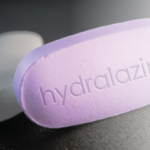She walked into the clinic exam room with slow steps and appeared tired. She recounted the “strong flu-like” symptoms that had started in December and described daily fevers at 4 p.m., as well as night sweats and rigors. Her appetite had faded, leading to a loss of 20 lbs. over the course of two months. Her cheeks became fatigued with chewing food, but she thought her new set of dentures might be at fault. Weakness had become a major problem, particularly in both thighs, such that she needed to firmly hold on to the banister when ascending or descending stairs for fear of falling. She also described new difficulty raising her arms to wash her hair. She complained of severe, bilateral anterior thigh pain and posterior calf pain, also new since December. These were limiting her ability to walk—as was dyspnea; prior to December she could walk several miles at a time, and now she could only walk four blocks due to shortness of breath. Swelling had developed in both calves and both feet. Her MCPs and PIPs were painful, but had not been swollen, red or warm.
She denied recent cough, hemoptysis, chest pain, dysphagia, dry eyes or mouth, eye pain or redness, sinus symptoms or epistaxis, hearing loss, vision loss, scalp tenderness, headache, arm claudication, morning stiffness, back pain, buttock or hip pain or stiffness, rash, abdominal pain, nausea, vomiting, diarrhea, dysuria, hematuria, decreased urine output and parasthesias.
Medical history included osteopenia and appendectomy. She was taking calcium and vitamin D supplements and 600 mg ibuprofen three times daily as needed for calf pain. She was born and raised in the Dominican Republic, had moved to Boston in 2011 and had a negative PPD in 2014. She was never a smoker and denied alcohol or illicit drug use, including cocaine. Her mother had died of esophageal cancer. There was no known history of autoimmune disease in the family.
The patient’s presentation raised several questions about the pathogenesis of her disease, whose answers could influence the treatment approach. Was this ILD, with an incidentally positive ANCA? … Or was this a new case of MPA with lung fibrosis & bronchiectasis?
On physical exam, she was afebrile, with normal blood pressure and oxygen saturation 99% on room air. Her weight was 20 lbs. lighter than two months prior. She appeared tired. Faint red patches were visible on the skin of her left forearm. The oropharynx had no ulcerations, and there was no conjunctival injection. Her scalp was non-tender to palpation. No cervical or supraclavicular adenopathy was palpable. Her lung exam was notable for bibasilar crackles to the mid-lung fields. The jugular venous pressure was 7 cm. The heart was tachycardic, regular, without murmur, rub or gallop. Temporal artery pulsations were full and symmetric. There were no carotid or subclavian bruits. The abdominal exam was benign. Extremity exam was notable for 2+ radial and dorsalis pedis pulses, 1+ pitting edema of the calves and feet, and extreme tenderness to palpation over the posterior calves and anterior thighs. Musculoskeletal exam revealed no synovitis and showed full range of motion in the upper and lower extremity joints. On neurologic exam, her strength was 5/5 with neck flexion and in the deltoids, symmetric 3+/5 in the triceps and biceps, 5/5 handgrip, symmetric 4/5 in the iliopsoas, quadriceps and hamstrings, and 5/5 in the anterior tibialis and gastrocnemius. Sensation was intact to light touch.

